How to create a fragrant and blooming night garden this summer
“Flowers don’t just make a beautiful place. They make beautiful memories. With a bit of guidance, anyone can enjoy a summer lit under the moon and bathed with sweet fragrance from lovely garden flowers. This will help create a safe space that can become their outdoor sanctuary,” says Shannen Godwin, spokesperson for one of the leading plant and bulb companies in the UK, J Parker’s.
With ‘hygge’ being long gone, ‘friluftsliv’, the open air living Danish concept, makes its way into the highlights of this season. As Brits spend more time in the garden during the warmer months, introducing night-blooming and night-fragrant plants will make their outdoor experience even more enjoyable.
What are night-blooming plants?
It is a tradition to enjoy the warm summer evening, dusk, or night outdoors. This allows you to see a beautiful sunset while soaking in the sweet scents of the plants in your garden.
Night-blooming plants or night-scented plants release their fragrance when dusk sets in. They’re known to not only create an ambient mood plus reminisce some special moments but also attract nocturnal pollinators such as moths. Night-fragrant plants are best suited for the garden but in specific areas. To take full advantage of the perfumes, you can also plant them around patios or terraces, a well-worn path, or an open window.
While there are many night-blooming plants you can include in your garden, here are the recommended types.
Angel’s trumpet
The angel’s trumpet is a trumpet-shaped flower with a strong scent. The Brugmansia Suaveolens is also known to grow up to 30cm in length, with colors ranging from soft orange and red to white.
This flower is also tender, so most gardeners are advised to plant it in pots which allows for winter protection when the conditions become unfavorable. You should also handle the angel’s trumpet with care since all parts of the plant are poisonous. Nonetheless, its sweet night fragrance makes it a great addition to your garden.
Wisteria
The wisteria is famed for not only being extremely fragrant at night but also very beautiful. The wisteria also gets a reputation of being very romantic, thanks to the striking vines and blossoms that it produces.
The Chinese wisteria, for instance, produces blue-violet blossoms, mostly between May and June. These drooping, large clusters of flowers grow from vigorous climbing vines that can grow up to 25 feet. Just take note that if you plan to plant the wisteria from scratch, the Chinese variant, in particular, takes about 20 years before it’s mature enough to start flowering.
Gardenia
This perennial shrub releases its fragrance both day and night. However, the smells intensify at night compared to the daytime fragrance. The Gardenia can work well both on your walkway and your yard. This way, you can enjoy its fragrance plus white flowers while looking at the sunset in your garden or as you walk back to your front door after a long day at work.
Evening Primrose
The evening primrose is a hardy perennial that not only releases a sweet fragrance over dusk but also adds a dash of bright colors. The evening primrose predominantly comes with bold, bright yellow flowers.
Lilac
The lilac plant (also known as Syringa) is easily identifiable with its blue, purple, and white cone-shaped flowers. Besides, the lilac flower is also known for its strong fragrance especially during late spring, coming into summer, which makes it one of the top choices for an early, night-blooming plant.
Another great thing about the lilac is that it’s tolerant and fairly easy to grow, making it a top contender in many gardens.
Mock orange
The mock orange is known for its pretty, small, white flowers, and orangey fragrance. Just like the lilac, the mock orange also announces the beginning of summer.
However, this shrub is hardy and can get quite large if not watched over.
Petunia
Petunias are also highly scented night-blooming plants. The Tumbelina variety in particular gives off a vanilla scent. For this plant, you can grow them in hanging pots or baskets in your yard, preferably next to walkways or windows.

